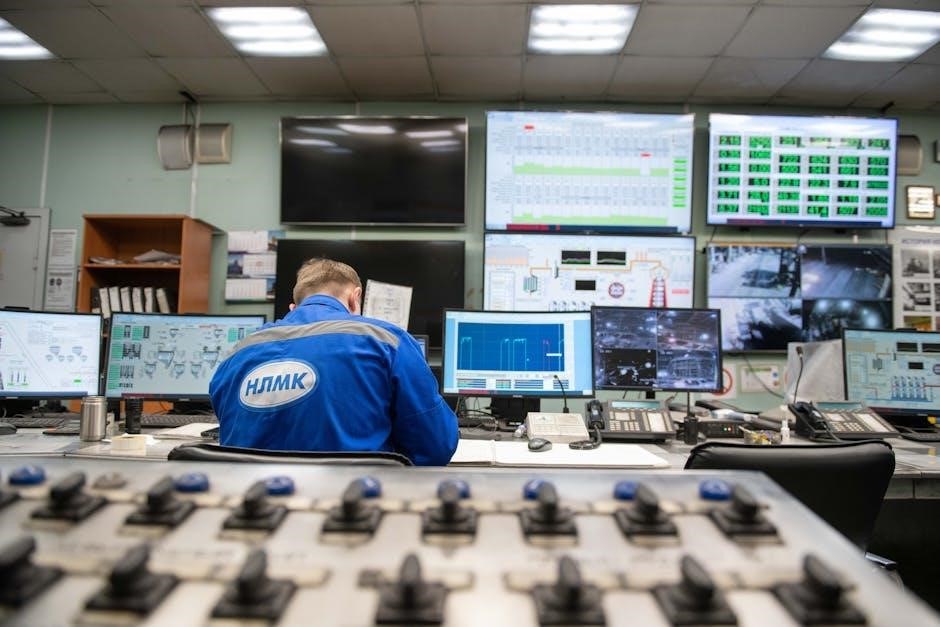The myth of multitasking, popularized by Dave Crenshaw’s book, challenges the belief that doing multiple tasks simultaneously boosts productivity. It distinguishes between harmful switchtasking and efficient background tasking.

Defining Multitasking and Its Misconceptions
Multitasking is often misunderstood as the ability to perform multiple tasks simultaneously. However, research reveals that true multitasking is a myth. What people perceive as multitasking is actually task-switching, where the brain rapidly shifts focus between tasks. This process incurs cognitive costs, such as decreased productivity and impaired memory. The misconception lies in believing multitasking enhances efficiency, when in fact, it hinders performance. Dave Crenshaw’s work highlights this by distinguishing between switchtasking, which harms productivity, and background tasking, which can be beneficial. The myth persists despite evidence showing that focusing on a single task yields better results;
The Evolution of Multitasking in Modern Society
The concept of multitasking originated in computing, describing parallel processing abilities. By the late 1990s and early 2000s, it transitioned to humans, fueled by advancements in technology and digital devices. Society embraced multitasking as a symbol of efficiency, with advertisements celebrating the ability to juggle multiple tasks. However, as research emerged, the myth began to unravel. Studies showed that constant task-switching led to decreased productivity and cognitive impairment. Despite this, multitasking remains a cultural phenomenon, often mistakenly viewed as a mark of high performance. This evolution highlights how societal trends can influence perceptions of productivity, even when contradicted by scientific evidence.

Understanding the Concept of Multitasking
Multitasking is often misunderstood as simultaneously handling multiple tasks. However, research reveals that true multitasking is rare; most people engage in switchtasking, constantly shifting focus between tasks.
The Difference Between Multitasking and Switchtasking
Multitasking, often misconceived as handling multiple tasks at once, is actually a myth. What most people do is switchtasking—rapidly shifting attention between tasks. This constant switching incurs cognitive costs, such as lost time, reduced performance, and increased stress. Unlike multitasking, switchtasking diminishes productivity and focus. Dave Crenshaw’s work emphasizes this distinction, explaining that true multitasking is rare and typically limited to tasks requiring minimal attention. Understanding this difference is crucial for improving efficiency and reducing mental fatigue in both personal and professional settings.
Background Tasking: A Productive Alternative
Background tasking is a productive approach where individuals perform a primary task while managing secondary, low-effort activities simultaneously. Unlike switchtasking, it doesn’t require constant attention shifts, minimizing cognitive costs. Examples include exercising while listening to music or delegating tasks to others. This method enhances productivity by leveraging routines or automation for mundane activities, allowing focus on high-value tasks. It aligns with Dave Crenshaw’s insights, offering a practical way to manage multiple responsibilities without the drawbacks of switchtasking, thus promoting efficiency and reducing mental fatigue in both personal and professional contexts.

The Science Behind the Myth
Research reveals multitasking impairs cognitive functions, reducing focus and memory retention. Continuous task-switching increases mental fatigue, lowering productivity and potentially harming long-term brain health.
Cognitive Costs of Multitasking
Research indicates that multitasking imposes significant cognitive costs. Switching between tasks disrupts focus, reduces mental accuracy, and slows processing speed. Each switch incurs a “switching cost,” diminishing productivity and increasing stress. Over time, frequent multitasking can impair memory consolidation and reduce the brain’s ability to filter distractions. Studies show that even short periods of multitasking can lead to mental fatigue, making it harder to concentrate on subsequent tasks. These cognitive costs highlight why prioritizing single-tasking often leads to better outcomes and overall efficiency in both personal and professional settings.
How Multitasking Affects Memory and Focus
Multitasking significantly impairs memory and focus by overloading working memory, which can only hold a limited amount of information. When tasks are divided, the brain struggles to store and retrieve details effectively, leading to forgetfulness and errors. Frequent switching between tasks reduces the ability to concentrate, as the mind expends energy resetting focus each time. This fragmentation of attention weakens long-term memory formation and hinders problem-solving skills. Over time, chronic multitasking can rewire the brain, making it less efficient at filtering distractions and maintaining focus on single tasks, ultimately undermining cognitive performance and productivity.
The Impact on Brain Health and Cognitive Functions
Chronic multitasking adversely affects brain health by altering neural pathways, reducing gray matter density, and diminishing cognitive flexibility. The constant switching of tasks overloads the prefrontal cortex, leading to mental fatigue and decreased problem-solving abilities. Over time, this can impair memory consolidation and retrieval, weakening long-term cognitive functions. The brain’s ability to filter distractions is also compromised, making focused thinking more challenging. Additionally, excessive multitasking has been linked to increased stress levels, which can further degrade overall brain health and reduce productivity, highlighting the importance of mindful task management for maintaining cognitive well-being.

Dave Crenshaw’s Perspective
Dave Crenshaw’s work challenges the notion of multitasking as efficient, arguing it hinders productivity and relationships. His insights emphasize focused task management over divided attention.
Overview of “The Myth of Multitasking” Book
Dave Crenshaw’s book, The Myth of Multitasking, debunks the idea that multitasking enhances productivity. Through a compelling business fable, Crenshaw illustrates how multitasking often leads to reduced efficiency and strained relationships. He distinguishes between “switchtasking” (constant attention shifts) and “background tasking” (managing mindless tasks alongside focused work). The book provides practical strategies to prioritize tasks and reduce distractions, emphasizing the importance of singular focus for achieving greater productivity and satisfaction. Crenshaw’s insights are supported by research, offering a clear path to overcoming the myth of multitasking.
The Author’s Insights on Task-Switching and Productivity
Dave Crenshaw argues that task-switching, often mistaken for multitasking, significantly reduces productivity. He explains that switching attention between tasks incurs “switching costs,” including lost time, decreased performance, and increased stress. Crenshaw emphasizes that true multitasking is a myth; instead, people engage in rapid task-switching, which hinders efficiency. He advocates for focusing on one task at a time to maximize productivity and reduce mental fatigue. By understanding the difference between switchtasking and background tasking, individuals can adopt strategies to minimize distractions and achieve greater results in both personal and professional settings.
The Role of Business Fables in Communicating the Message
Dave Crenshaw effectively uses business fables to simplify complex ideas, making them relatable and engaging. These fables illustrate how multitasking myths impact productivity and relationships, offering practical lessons. By presenting real-life scenarios, Crenshaw helps readers connect emotionally with the concepts, enhancing understanding and retention. The fables break down myths, revealing the true costs of task-switching and promoting focus as a superior strategy. This storytelling approach makes the book accessible to a broad audience, ensuring the message resonates deeply and motivates meaningful change in work and personal habits.

Historical and Cultural Context
Multitasking’s origins trace back to computing, where it described parallel processing. Culturally, it became a workplace trend, symbolizing efficiency, though research now disputes its benefits.
The Origins of Multitasking in Computing
The term “multitasking” originally described computers handling multiple processes simultaneously. In the 1960s, operating systems like OS/360 introduced time-sharing, allowing efficient task switching. This concept later influenced human behavior, promoting the idea of parallel task execution. However, research reveals that humans cannot truly multitask; instead, they switch between tasks, incurring cognitive costs. This misunderstanding has led to productivity myths, as highlighted in Dave Crenshaw’s work, which distinguishes between multitasking and more efficient practices like background tasking.
How Multitasking Became a Workplace Trend
Multitasking became a workplace trend as digital devices proliferated in the late 1990s and early 2000s. Companies embraced the idea of employees handling multiple tasks to meet rising demands. The belief that multitasking boosted efficiency grew, despite research showing it reduces productivity by up to 40%. The cultural shift glorified multitasking as a skill, even though it often led to errors and stress. This trend was further fueled by the marketing of gadgets promising to enhance multitasking abilities, solidifying its place in workplace culture, despite its counterproductive nature.
Cultural Perceptions of Multitasking Across Generations
Cultural perceptions of multitasking vary across generations, with younger generations often viewing it as a necessary skill. Millennials and Gen Z, who grew up with digital devices, are perceived as natural multitaskers. However, research shows that while they may handle multiple tasks simultaneously, the quality of their work often suffers. Older generations, by contrast, often prefer focused, single-task approaches, viewing multitasking as a sign of distraction rather than efficiency. These differing perceptions highlight the complex relationship between multitasking and productivity across age groups, challenging the notion of multitasking as universally beneficial.

Debunking Common Myths
A common myth is that multitasking is efficient, but research reveals it reduces productivity and increases errors, proving it less effective than focused, single-task approaches.
Myth: Multitasking is Efficient
The belief that multitasking is efficient is a widespread misconception. Research shows that multitasking reduces productivity by up to 40% due to cognitive costs like task-switching. The brain cannot handle multiple complex tasks simultaneously, leading to errors and decreased focus. This myth persists despite evidence that sequential task completion yields better results. Multitasking often results in divided attention, poor memory retention, and increased stress. In reality, true efficiency comes from focused, single-tasking approaches, not the illusion of juggling multiple tasks at once. This myth has significant implications for workplace productivity and personal well-being.
Myth: Only Younger Workers Multitask
The assumption that only younger workers multitask is incorrect. Multitasking is prevalent across all age groups in the workforce. Both younger and older employees engage in multitasking due to demanding work environments and the pressure to meet deadlines. Research indicates that while younger workers may be more accustomed to digital multitasking, older workers also juggle multiple tasks, though they may prefer different strategies. This myth overlooks the universal nature of multitasking in modern workplaces, where employees of all generations face similar challenges in managing their workload. The idea that multitasking is generation-specific is not supported by evidence.
Myth: Multitasking is a Sign of Intelligence
Believing multitasking is a sign of intelligence is a common misconception. In reality, studies show that frequent task-switching can impair cognitive functions like memory and focus. Multitasking often reflects a response to overwhelming demands rather than heightened intellectual ability. Intelligence is better demonstrated through strategic thinking and effective prioritization, not the ability to juggle multiple tasks inefficiently. This myth perpetuates the idea that busyness equates to brilliance, distracting from the true measures of intellectual capability, such as problem-solving and innovation.

Real-Life Implications
Multitasking’s real-life implications include reduced workplace productivity, strained personal relationships, and increased safety risks in critical situations. It undermines focus and efficiency, affecting overall quality of life.
How Multitasking Affects Workplace Productivity
Multitasking, often misconceived as efficient, significantly reduces workplace productivity. Switchtasking, the constant shifting of attention between tasks, incurs cognitive costs, including time loss and increased stress. Studies reveal that multitasking can decrease productivity by up to 40%, as the brain struggles to refocus. This leads to errors, lower quality work, and prolonged task completion times. Furthermore, chronic multitasking impairs memory and focus, undermining long-term professional performance. By prioritizing single-tasking, employees can enhance efficiency, reduce burnout, and achieve better outcomes, ultimately benefiting both personal and organizational success.
The Impact on Personal Relationships
Multitasking significantly strains personal relationships by reducing emotional presence and fostering misunderstandings. Constant task-switching leads to divided attention, making individuals seem distant or unengaged in conversations. This can erode trust and intimacy, as others feel neglected or unimportant. Over time, the habit of multitasking may result in superficial interactions, weakening emotional bonds. By prioritizing focused communication, individuals can strengthen their connections, ensuring more meaningful and fulfilling relationships. Balancing productivity with mindful engagement is crucial for maintaining healthy personal dynamics in a fast-paced world.
Multitasking in Critical Situations: Safety and Errors
Multitasking in critical situations, such as driving or medical procedures, significantly increases the risk of errors and compromises safety. Research indicates that divided attention impairs reaction times and accuracy, leading to potentially disastrous outcomes. While individuals may believe they are multitasking effectively, studies reveal that the brain cannot process multiple complex tasks simultaneously without degradation in performance. This cognitive limitation heightens the likelihood of accidents and mistakes in high-stakes environments. Therefore, focusing on a single task at a time is essential to ensure safety and minimize risks in critical situations.

The Future of Multitasking
The future of multitasking lies in technology reducing distractions and promoting focus, fostering productivity without cognitive overload.
Adapting to a World That Values Focus
As society recognizes the inefficiency of multitasking, the shift toward valuing focus is gaining momentum. Individuals and organizations are redefining productivity, prioritizing tasks, and implementing time management techniques to minimize distractions. The concept of background tasking is being embraced as a productive alternative, while switchtasking is increasingly understood as harmful. By adapting to a focus-oriented mindset, people can enhance creativity, innovation, and overall well-being. This cultural shift encourages mindful work practices, reducing stress and errors while fostering deeper engagement in personal and professional life.
The Role of Technology in Reducing Multitasking
Technology, often blamed for enabling multitasking, can also be a solution. Tools like website blockers, focus-enhancing apps, and task management software help individuals concentrate on single tasks; By automating repetitive processes, technology reduces the need for constant task-switching. Additionally, digital tools can monitor and provide insights into multitasking habits, encouraging users to adopt more focused work patterns. While technology initially fueled multitasking, it now plays a crucial role in helping people prioritize and maintain concentration, aligning with the principles outlined in The Myth of Multitasking.
Strategies for Managing Multiple Tasks Effectively
Effective task management begins with prioritization and focus. Techniques like time-blocking and the Pomodoro method help individuals dedicate uninterrupted time to critical tasks. Delegation and automation can reduce workloads, while task segmentation breaks complex projects into manageable steps. Regular breaks and mindfulness practices improve concentration, reducing the urge to multitask. By adopting these strategies, individuals can enhance productivity and reduce stress, aligning with the insights from The Myth of Multitasking on achieving efficiency through focused effort rather than divided attention.
The myth of multitasking is debunked in Dave Crenshaw’s work, emphasizing that focused efforts, not divided attention, lead to genuine productivity and efficiency.
Summarizing the Key Points
The myth of multitasking, as explored in Dave Crenshaw’s work, reveals that true productivity lies in focus, not divided attention. Multitasking is often a misnomer for switchtasking, which incurs cognitive costs, reduces efficiency, and impairs memory. Background tasking, in contrast, can enhance productivity when combined with mindful prioritization. The book emphasizes that multitasking is neither inherently good nor bad but often misunderstood. By distinguishing between these concepts, individuals and organizations can adopt strategies that foster clarity, reduce distractions, and promote meaningful achievements in both personal and professional realms.
Final Thoughts on the Myth of Multitasking
The myth of multitasking, as explored by Dave Crenshaw, underscores the illusion of productivity through simultaneous tasking. In reality, constant switching between tasks leads to cognitive overload, reduced efficiency, and diminished focus. True productivity lies in prioritizing tasks and dedicating undivided attention to what matters most. By recognizing the distinction between harmful switchtasking and efficient background tasking, individuals can adopt healthier work habits. Embracing focus and mindfulness fosters better outcomes, encouraging a shift away from the multitasking myth toward a more intentional approach to work and life.

Further Reading and Resources
- Downloadable PDF guides and exercises by Dave Crenshaw.
- Research papers on multitasking myths.
- NPR interview on the myth of multitasking.
Recommended Books and Articles
Explore Dave Crenshaw’s The Myth of Multitasking: How Doing It All Gets Nothing Done, a thought-provoking read on the inefficiency of multitasking. For deeper insights, download the Myth of Multitasking Exercise PDF. Additionally, research articles like “The Myth of Media Multitasking” and “The Myth of Multitasking” by NPR offer scientific perspectives. These resources provide a comprehensive understanding of the topic.
Downloadable PDF Guides and Exercises
Enhance your understanding of multitasking myths with downloadable resources like Dave Crenshaw’s Myth of Multitasking Exercise PDF. This guide offers practical tools to identify switchtasking versus background tasking. Additionally, find worksheets and infographics that simplify complex concepts. These resources are designed to help you implement focus-driven strategies for better productivity. Visit Dave Crenshaw’s website to access these materials and start your journey toward effective task management.
